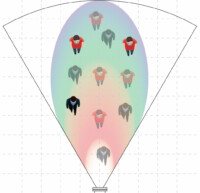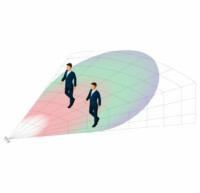Detecting objects in separate dimensions –
Improve your knowledge about radar resolution!
Radar sensor technology is an active transmission and reception method in the microwave GHz range and is used for contactless detection, tracking and localization of one or more objects using electromagnetic waves. The radar sensor emits a signal which is reflected back to the sensor by the object to be detected. The received signal is then processed. Depending on the modulation and antenna configuration, radar measures various parameters. The radar resolution can be classified on the basis of these features.
What exactly is radar resolution?
The term “radar resolution” describes the ability of a radar to clearly separate nearby targets (separability). If two objects are very close to another, there is a risk that they will merge into one object. But for some applications it is very important to detect every single target (e.g. security monitoring). So, objects which are located near to each other shall be reliably separated by radar.
Important: The resolution of a radar gives no information about the measuring accuracy. The precision of the measurement results is depending primarily on other parameters (method of signal processing, framerate (observation time), bandwidth and frequency).
Radar experts often use the related term “multi-target capability” in the course of radar resolution and separability. This describes the ability of a radar to clearly detect and differentiate between several objects.
There are two types of radar resolution: range and angular resolution.
The radial resolution
It describes the resolution capability over the distance. The range resolution is defined by the bandwidth of the transmission signal. The decisive factor is not the chosen frequency bandwidth of the radar transmitter (e.g. 24 GHz band), but the bandwidth available within it (e.g. 250 MHz). Because this defines the smallest measurable distance.
The distance resolution can be determined by the transmission pulse duration, the speed and the distance covered by the signal. The larger the actually used, absolute bandwidth of the radar sensor, the shorter the transmission pulse and the better the distance resolution.
The radar device separates the objects by their difference in distance. Objects that are positioned at the same side and height angles to the radar are reliably kept apart by the radar via the distance detection. However, localizing them is not possible using the distance resolution alone.
The angular resolution
This type of radar resolution describes the resolving power by determining the angle. The radar separates the targets based on the information at which angle the objects are located to the radar.
If the objects are at the same distance from the radar device, the angular resolution indicates the necessary angular distance ratio between two objects in order to clearly differentiate them from another. In addition to the measurement of the lateral angle (azimuth resolution), the resolution in elevation angle (elevation resolution) can also be realized. Other common terms for indicating the value is “horizontal” for azimuth and “vertical” for elevation angle.
Here, the aperture angle (field of view) of the antenna is important. And its performance is influenced by the number and design of antennas. To achieve a better resolution, the radar technology uses the MIMO method.
The term “MIMO” means multiple input – multiple output and stands for the combination of several transmitting and receiving antennas. By arranging several antennas, the detection area can be divided into individual, virtual segments.
This creates a field broken down into distance and angle, which stretches itself imaginatively over the detection area. The more antennas, the higher the number of angle elements. Equally, applies, the finer the segments, the better the multi-target capability. With this radar method, it is possible to locate objects in a room.
Object separation using different measured variables
The resolution capability of a radar can be categorized into different dimensions. They are predestined by the measurable parameters of the selected radar modulation (CW, FSK, FMCW, MIMO). According to the current state of technology for commercial use, radar detections can be displayed using four different measurement parameters, therefore in four available dimensions. These are speed, distance and angular resolution in azimuth and elevation.
Overview of radar resolutions by dimensions
The separability of the radar sensors can be represented in a simplified way by assigning them to the different measurement dimensions and the type of radar.
1D radar (CW)
With continuous wave radar, the separation takes place via only one parameter, the speed of a moving object. It is therefore not possible to reliably separate objects at the same speed. Object location can’t be provided due to the lack of distance information. A CW radar uses the Doppler effect to carry out speed measurements without contact. This is used for classic motion detectors.
2D radar (FMCW)
With an FMCW radar, the frequency of the continuous wave radar is time-modulated (Frequency modulated continuous wave radar) in order to carry out distance measurements. The object is separated using the two measurement dimensions: speed and distance. This enables localization in a one-dimensional environment. But the radar device cannot distinguish between objects that are on a line (equal distance to the radar device and speed). One use option for this radar type is speed measurement of vehicles for digital traffic signs.
3D radar (MIMO-FMCW)
In combination with the MIMO method, the FMCW radar has a three-dimensional radar resolution: the first dimension separates objects by speed, the second by distance and the third by the division into angle segments (MIMO angular resolution). This enables localization in a two-dimensional environment. These systems are ideal for security monitoring.
4D Radar (MIMO-FMCW)
The advancement of technology now offers another dimension of resolution. Here the object is separated using four parameters: speed, distance and the horizontal and vertical angular resolution. Objects can be captured in a two-dimensional environment. These radar systems take on complex tasks such as traffic detection at intersections.
Further development of radar resolution
Today, inexpensive solutions that support our everyday life with easy integration options are in demand. Especially, autonomous driving needs advanced sensors technology and is a large field of application. There, but also in the area of security, is an increasing market. The industry is searching for the most reliable and precise device. Because for these use cases, measurement errors can have fatal consequences.
So, radar experts are working hard to further develop the radar resolution. This is one crucial aspect in order to improve the reliability of radar technology. High Definition radar resolution allows the most accurate and precise detection possible. The acceptance of the technology rises with increasing accuracy.
One of the biggest challenges of current radar solutions is signal processing. Because the higher the angular resolution, the more data is captured. The available computing capacity also limits the signal evaluation. With the help of new methods of deep learning, the first advances have already been made in order to achieve high resolution in the low-cost area.
Header Picture Source: © alotofpeople by adobestock.com
Share this Content
Get this technology on your radar
Information on this advanced sensor technology
The demand for sensors is increasing due to trends such as digitalisation, automation in industry & logistics, smart homes & cities, and autonomous driving. But the development and integration of radar units is a complex topic, and the technical terms and functions raise many questions for users. Our radar experts have put together comprehensive information to help you get started in the world of radar.






